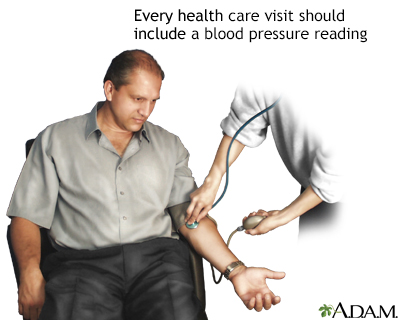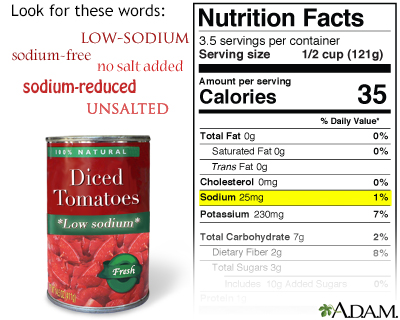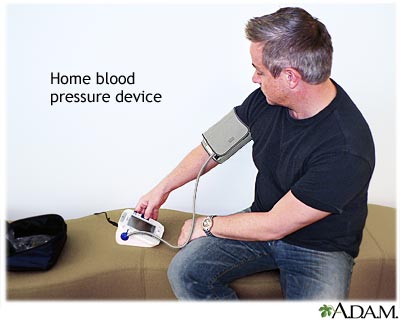Controlling your high blood pressure
Hypertension is another term used to describe high blood pressure. High blood pressure can lead to:
- Stroke
Stroke
A stroke occurs when blood flow to a part of the brain stops. A stroke is sometimes called a "brain attack. " If blood flow is cut off for longer th...
 ImageRead Article Now Book Mark Article
ImageRead Article Now Book Mark Article - Heart attack
Heart attack
Most heart attacks are caused by a blood clot that blocks one of the coronary arteries. The coronary arteries bring blood and oxygen to the heart. ...
 ImageRead Article Now Book Mark Article
ImageRead Article Now Book Mark Article - Heart failure
Heart failure
Heart failure is a condition in which the heart is no longer able to pump oxygen-rich blood to the rest of the body efficiently. This causes symptom...
 ImageRead Article Now Book Mark Article
ImageRead Article Now Book Mark Article - Kidney disease
Kidney disease
Chronic kidney disease is the slow loss of kidney function over time. The main job of the kidneys is to remove wastes and excess water from the body...
 ImageRead Article Now Book Mark Article
ImageRead Article Now Book Mark Article - Early death
You are more likely to have high blood pressure as you get older. This is because your blood vessels become stiffer as you age. When that happens, your blood pressure goes up.
Essential hypertension - Animation
Carrying a lot of extra weight around your middle or sprinkling too much salt onto your food at each meal can cause high blood pressure, otherwise known as hypertension. Stress and your genes can also bring your blood pressure up. Sometimes when your blood pressure is high, your doctor might not be able to find any direct cause for it. That's what's called essential hypertension. When your doctor talks to you about your blood pressure, he's referring to the force of your blood pushing against your artery walls. The top number in your blood pressure is called the systolic blood pressure. That's the pressure in your blood vessels while your heart is pumping. The bottom number is called the diastolic blood pressure and that's the pressure when your heart rests between beats. You want your blood pressure to stay at 120 over 80 or less. A blood pressure of 140 over 90 or more is considered high. Why is high blood pressure a problem, you ask? Well, you can think of high blood pressure as being like a river that's rushing too hard, eventually it's going to damage its banks. With high blood pressure, the extra force of your blood pushing against your artery walls eventually damages them. It can also damage your heart, your kidneys, and other organs. So, how do you know if you have high blood pressure? Often you don't know, because high blood pressure doesn't have symptoms like a fever or cough. Usually there are no symptoms at all, and you won't be able to find out that you have high blood pressure unless you've had it checked, or you've developed complications like heart disease or kidney problems. You can check your blood pressure yourself with a home monitor, or have it checked at your doctor's office. If it's high, you and your doctor will set a blood pressure goal. You can achieve that goal in different ways, like eating a healthy diet, exercising for at least 30 minutes a day, quitting smoking, eating less than 1,500 milligrams of salt per day, and using programs like meditation and yoga to relieve your stress. But if these lifestyle changes aren't enough, your health care provider might prescribe one or more medicines to lower your blood pressure. The reason why doctors are so serious about a patients' blood pressure is that having uncontrolled blood pressure can cause a lot of serious health problems, including heart attack, stroke, kidney disease, and loss of vision. When it comes to your blood pressure, it's best to be proactive. Call your doctor for a check-up if you haven't had one in a while, and get your blood pressure checked. If it's high, follow your doctor's advice for bringing it back into a healthy range.
When is Your Blood Pressure a Concern?
If your blood pressure is high, you need to lower it and keep it under control. Your blood pressure reading has 2 numbers. One or both of these numbers can be too high.
- The top number is called the systolic blood pressure. For most people, this reading is too high if it is 130 or higher.
- The bottom number is called the diastolic blood pressure. For most people, this reading is too high if it is 80 or higher.
The above blood pressure numbers are goals that most experts agree on for most people. For some people age 60 years and above, some health care providers recommend a different blood pressure goal. Some patients may have blood pressure goals lower than these targets, in particular circumstances. Your provider will work with you to create a blood pressure goal that applies to you specifically.
Hypertension - overview - Animation
If left untreated, hypertension can lead to a thickening of arterial walls, causing the lumen, or blood passageway, to narrow in diameter. As a result, the heart must work harder to pump blood through the narrowed arterial openings. In addition, people with hypertension may be more susceptible to stroke.
Medicines for Blood Pressure
Many medicines can help you control your blood pressure. Your provider will:
- Prescribe the best medicine for you
- Monitor your medicines
- Make changes if needed
Older adults tend to take more medicines and this puts them at greater risk for harmful side effects. One side effect of blood pressure medicine is an increased risk for falls. When treating older adults, blood pressure goals need to be balanced against medicine side effects.
Diet, Exercise, and Other Lifestyle Changes
In addition to taking medicine, you can do many things to help control your blood pressure. Some of these include:
Heart disease - modifiable risk factor types - Animation
Modifiable risk factors include hyperlipidemia, hypertension, obesity, diabetes mellitus, physical inactivity, and smoking.
- Limit the amount of sodium (salt) you eat. Aim for less than 1,500 mg per day.
- Limit how much alcohol you drink, no more than 1 drink a day for women and 2 a day for men.
- Eat a heart-healthy diet that includes the recommended amounts of potassium and fiber.
- Drink plenty of water.
- Stay at a healthy body weight. Find a weight-loss program, if you need it.
- Exercise regularly. Get at least 40 minutes of moderate to vigorous aerobic exercise at least 3 to 4 days a week aiming for at least 150 minutes per week.
- Reduce stress. Try to avoid things that cause you stress, and try meditation or yoga to de-stress.
- If you smoke, quit. Find a program that will help you stop.
Your provider can help you find programs for losing weight, stopping smoking, and exercising. You can also get a referral to a dietitian from your provider. The dietitian can help you plan a diet that is healthy for you.
Stopping smoking
There are many ways to quit smoking. There are also resources to help you. Family members, friends, and co-workers may be supportive. But to be su...

Checking Your Blood Pressure
Your blood pressure can be measured at many places, including:
- Home
- Your provider's office
- Some local fire stations
- Some pharmacies
Your provider may ask you to keep track of your blood pressure at home. Make sure you get a good quality, well-fitting home device. It is best to have one with a cuff for your arm and a digital readout. Practice with your provider to make sure you are taking your blood pressure correctly.
Home device
Your health care provider may ask you to keep track of your blood pressure at home. To do this, you will need to get home blood pressure monitor. T...
Read Article Now Book Mark ArticleIt is normal for your blood pressure to be different at different times of the day.
It is most often higher when you are at work. It drops slightly when you are at home. It is most often lowest when you are sleeping.
It is normal for your blood pressure to increase suddenly when you wake up. For people with very high blood pressure, this is when they are most at risk for heart attack and stroke.
Heart attack
Most heart attacks are caused by a blood clot that blocks one of the coronary arteries. The coronary arteries bring blood and oxygen to the heart. ...

Stroke
A stroke occurs when blood flow to a part of the brain stops. A stroke is sometimes called a "brain attack. " If blood flow is cut off for longer th...

Tracking your blood pressure at home - Animation
Following your blood pressure at home has gotten a lot easier in the last few years. I'm Dr. Alan Greene. I'd like to share with you a little bit about that. Not too long ago when you wanted to follow your blood pressure at home, you had to have the old fashioned sphygmomonometer, and the device was a complex as that word sounds. You had to pump something up, and put a stethoscope in your ears, and fumble all these different tubes and even so wouldn't get a very accurate reading. Now, there are simple, high quality, digital blood pressure cuffs. They're easy to use at home. They're built so they snap on the arm very easily, just press a single button, and the chip inside does the work for you. It blows it up, it gives you the reading, and some of the newer models even connect it to your PC and track the readings for you. Now, how accurate are they? They're really pretty good. I wouldn't trust a single reading that much if you get one that's high or low. I wouldn't be either reassured or panicked. But, I would trust the pattern of readings. So, if you have one that tracks it for you, that's great, if not, just write them down what date and time you took it and see what the pattern is over time. If there's anything of concern, be sure to report it to your physician.
Follow-up
Your provider will give you a physical exam and check your blood pressure often. With your provider, establish a goal for your blood pressure.

Blood pressure check
To measure blood pressure, your doctor uses an instrument call a sphygmomanometer, which is more often referred to as a blood pressure cuff. The cuff is wrapped around your upper arm and inflated to stop the flow of blood in your artery. As the cuff is slowly deflated, your doctor uses a stethoscope to listen to the blood pumping through the artery. These pumping sounds register on a gauge attached to the cuff. The first pumping sound your doctor hears is recorded as the systolic pressure, and the last sound is the diastolic pressure.
If you monitor your blood pressure at home, keep a written record. Bring the results to your office visit.
When to Call the Doctor
Contact your provider if your blood pressure goes well above your normal range.
Also contact your provider if you have any of the following symptoms:
- Severe headache
Headache
A headache is pain or discomfort in the head, scalp, or neck. Serious causes of headaches are rare. Most people with headaches can feel much better...
 ImageRead Article Now Book Mark Article
ImageRead Article Now Book Mark Article - Irregular heartbeat or pulse
Irregular heartbeat
Palpitations are feelings or sensations that your heart is pounding or racing. They can be felt in your chest, throat, or neck. You may:Have an unpl...
 ImageRead Article Now Book Mark Article
ImageRead Article Now Book Mark Article - Chest pain
Chest pain
Chest pain is discomfort or pain that you feel anywhere along the front of your body between your neck and upper abdomen.
 ImageRead Article Now Book Mark Article
ImageRead Article Now Book Mark Article - Sweating
- Nausea or vomiting
- Shortness of breath
- Dizziness or lightheadedness
Dizziness
Dizziness is a term that is often used to describe 2 different symptoms: lightheadedness and vertigo. Lightheadedness is a feeling that you might fai...
 ImageRead Article Now Book Mark Article
ImageRead Article Now Book Mark Article - Pain or tingling in the neck, jaw, shoulder, or arms
- Numbness or weakness in your body
- Fainting
Fainting
Fainting is a brief loss of consciousness due to a drop in blood flow to the brain. The episode most often lasts less than a couple of minutes and y...
Read Article Now Book Mark Article - Trouble seeing
- Confusion
Confusion
Confusion is the inability to think as clearly or quickly as you normally do. You may feel disoriented and have difficulty paying attention, remembe...
 ImageRead Article Now Book Mark Article
ImageRead Article Now Book Mark Article - Difficulty speaking
- Other side effects that you think might be from your medicine or your blood pressure
Reviewed By
Michael A. Chen, MD, PhD, Associate Professor of Medicine, Division of Cardiology, Harborview Medical Center, University of Washington Medical School, Seattle, WA. Also reviewed by David C. Dugdale, MD, Medical Director, Brenda Conaway, Editorial Director, and the A.D.A.M. Editorial team.
American Diabetes Association Professional Practice Committee. 10. Cardiovascular disease and risk management: standards of medical care in diabetes-2024. Diabetes Care. 2024;47(Supplement 1):S179-S218. PMID: 38078592 pubmed.ncbi.nlm.nih.gov/38078592/.
Bakris GL, Sorrentino MJ. Systemic hypertension: mechanisms, diagnosis, and treatment. In: Libby P, Bonow RO, Mann DL, Tomaselli GF, Bhatt DL, Solomon SD, eds. Braunwald's Heart Disease: A Textbook of Cardiovascular Medicine. 12th ed. Philadelphia, PA: Elsevier; 2022:chap 26.
Flack JM. Arterial Hypertension. In: Goldman L, Cooney KA, eds. Goldman-Cecil Medicine. 27th ed. Philadelphia, PA: Elsevier; 2024:chap 64.
Whelton PK, Carey RM, Aronow WS, et al. ACC/AHA/AAPA/ABC/ACPM/AGS/APhA/ASH/ASPC/NMA/PCNA guideline for the prevention, detection, evaluation, and management of high blood pressure in adults: a report of the American College of Cardiology/American Heart Association Task Force on clinical practice guidelines. J Am Coll Cardiol. 2018;72(3):e33. PMID: 29133354 pubmed.ncbi.nlm.nih.gov/29133354/.






 All rights reserved.
All rights reserved.